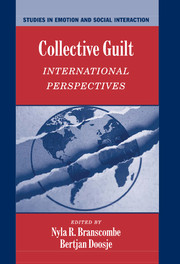Book contents
- Frontmatter
- Contents
- Preface
- List of Contributors
- Collective Guilt
- Section 1 Defining the nature of collective guilt
- 1 International Perspectives on the Experience of Collective Guilt
- 2 The Measurement of Collective Guilt: What It Is and What It Is Not
- 3 The Evocation of Moral Emotions in Intergroup Contexts: The Distinction Between Collective Guilt and Collective Shame
- 4 Collective Guilt in the United States: Predicting Support for Social Policies that Alleviate Social Injustice
- 5 Gender Inequality and the Intensity of Men's Collective Guilt
- Section 2 The Relationship Between Group Identification and Collective Guilt
- Section 3 Consequences for Intergroup Relations
- Section 4 Commentary on the Volume
- Index
- References
4 - Collective Guilt in the United States: Predicting Support for Social Policies that Alleviate Social Injustice
Published online by Cambridge University Press: 05 January 2012
- Frontmatter
- Contents
- Preface
- List of Contributors
- Collective Guilt
- Section 1 Defining the nature of collective guilt
- 1 International Perspectives on the Experience of Collective Guilt
- 2 The Measurement of Collective Guilt: What It Is and What It Is Not
- 3 The Evocation of Moral Emotions in Intergroup Contexts: The Distinction Between Collective Guilt and Collective Shame
- 4 Collective Guilt in the United States: Predicting Support for Social Policies that Alleviate Social Injustice
- 5 Gender Inequality and the Intensity of Men's Collective Guilt
- Section 2 The Relationship Between Group Identification and Collective Guilt
- Section 3 Consequences for Intergroup Relations
- Section 4 Commentary on the Volume
- Index
- References
Summary
In 1964, the United States government admitted the nation continued to have a problem with race relations. Although slavery had officially ended nearly a century before, a deep racial divide remained between Black and White Americans. In an effort to improve intergroup relations, the government created Title VII of the Civil Rights Act. Title VII prohibited discriminatory practices toward applicants for employment based on race, color, religion, sex, or national origin. Several other legislative acts have made discrimination illegal in different domains (e.g., school desegregation), and blatant acts of racism have diminished since 1964 (Dovidio & Gaertner, 1991; 1998). Yet these laws are being rapidly overturned and discrimination still remains, albeit in a subtler, more ambiguous form (Feagin & Sikes, 1994; Stephan & Stephan, 2000; Swim et al., 2001). Nearly every American has an opinion on issues of race and racism; some believe that racism still exists and others adamantly disagree (McConahay, 1986; Sniderman & Tetlock, 1986). Regardless of which side of the coin opinion is on, it is sure to be strongly held and accompanied by emotion (Smith, 1993; Zanna, 1994).
Perhaps because of the prevalence of these ambivalent opinions and controversy in policy, in 1997 President Clinton issued Executive Order No. 13050 that created the Initiative on Race and an advisory board to make recommendations on how to build a unified nation for the coming century. Board members spent over a year gathering information from around the country on how racism has affected lives.
- Type
- Chapter
- Information
- Collective GuiltInternational Perspectives, pp. 56 - 74Publisher: Cambridge University PressPrint publication year: 2004
References
- 13
- Cited by

